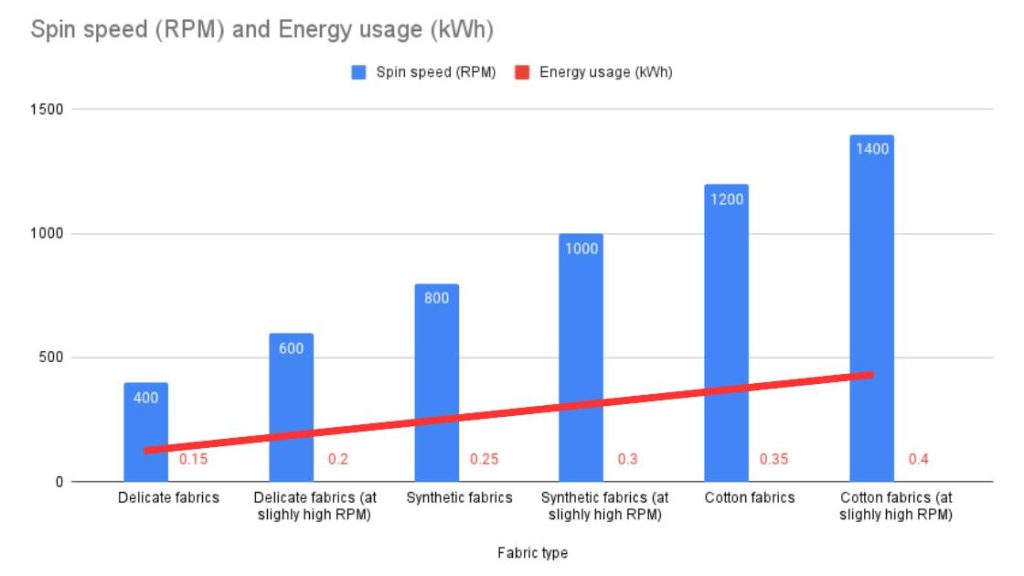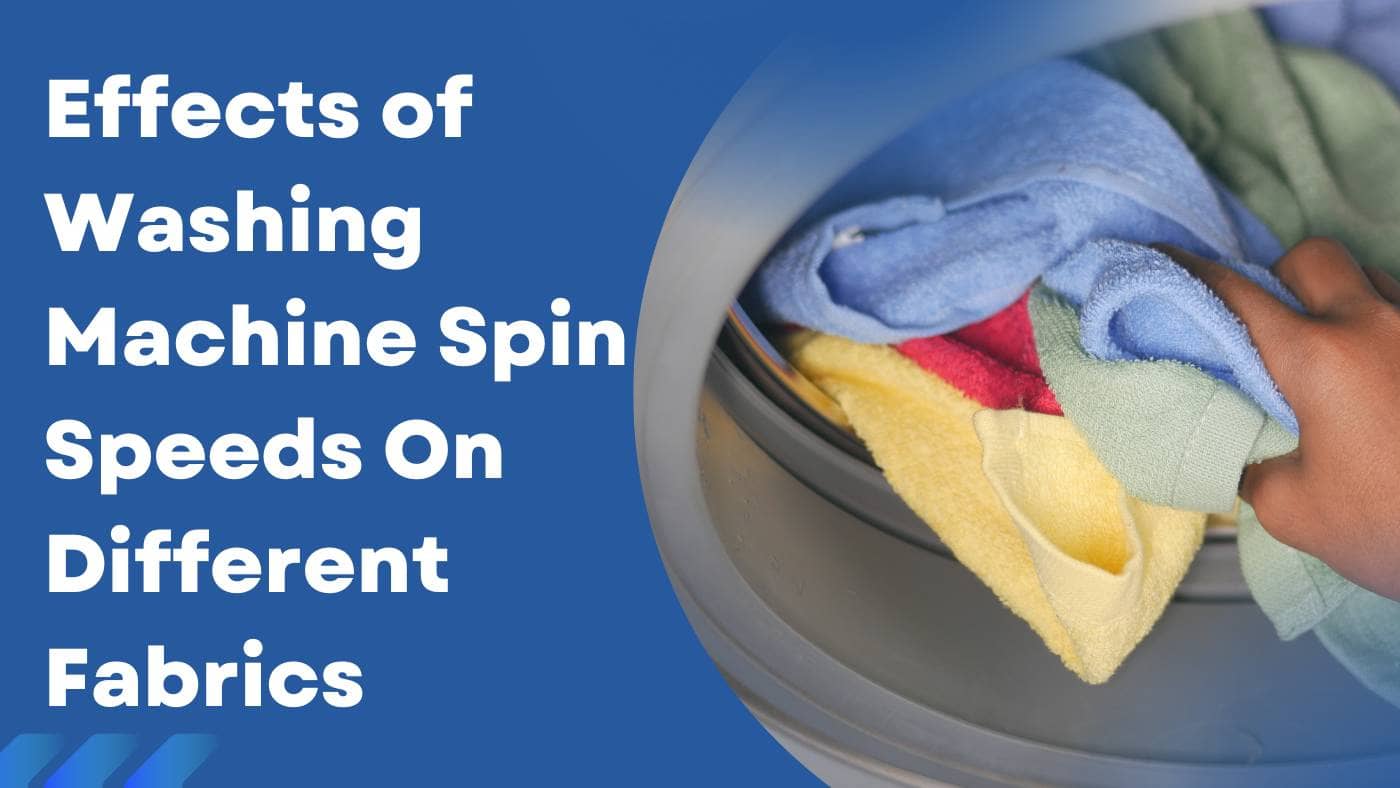Washing machines have become an indispensable appliance in our daily lives, significantly impacting how we manage our laundry.
In this article, we’ll go through the complex relationship between washing machine spin speed and the fabric of our clothing, shedding light on how different spin speeds can either preserve or cause damage to various types of fabrics.
Table of Contents
Why is it essential to consider the spin speed when washing different types of fabrics?
Selecting the appropriate spin speed is not just about following the laundering instructions on the care label, it’s about safeguarding your clothing from unnecessary wear and tear.
Different fabrics, be it cotton, wool, silk, or synthetic fabrics like polyester and nylon, have unique characteristics and react differently to various spin speeds.
Balancing spin speed with fabric type is key to avoiding fabric damage and ensuring effective washing.
Understanding Spin Speed
Spin speed, measured in RPM (Revolutions Per Minute), refers to how fast the drum of the washing machine rotates to extract water from the clothes.
Modern washing machines offer a range of spin speeds, typically between 400 RPM to 1600 RPM, allowing you to choose the best option based on the fabric type and laundering instructions.
The chosen speed can significantly impact water usage, energy efficiency, and noise level during the washing process.
What are the common spin speeds available in modern washing machines, and how do they impact the washing process?
Modern washing machines are equipped with various spin speeds, each designed to cater to the needs of different fabric types.
Lower spin speeds around 400-800 RPM are generally suitable for delicate fabrics like silk and lace, preventing shrinkage and fading.
On the other hand, higher spin speeds, ranging from 1000-1600 RPM, are ideal for durable fabrics like cotton and linen, effectively removing water and reducing drying time.
Understanding how to choose the right spin speed for your laundry is essential to prevent clothing damage and optimize the washing process.
By sticking to the laundering instructions and considering the fabric type, users can ensure fabric durability and wear and tear resistance, while also maximizing energy efficiency and minimizing water usage.
The Relationship Between Spin Speed and Fabric Type
How Different Fabrics Respond to Various Spin Speeds?
Every piece of clothing we own, from casual cotton tees to luxurious silk dresses, has a unique identity, primarily defined by its fabric type.
For instance, delicate fabrics like lace and rayon necessitate lower spin speeds, safeguarding them from wear and tear, while durable fabrics such as linen and wool can withstand higher speeds, optimizing water usage and energy efficiency.
The Significance of Fabric Weight and Composition
Peeling back the layers, we find that the fabric weight and composition play a significant role in determining the optimal spin speed.
Heavy fabrics like denim and towels often require higher spin speeds to effectively remove water, whereas lightweight synthetic fabrics such as polyester and nylon benefit from moderate speeds to maintain their structure and prevent fading.
Additionally, the blend of materials, whether it’s spandex with cotton or acetate with rayon, can influence the laundry instructions and care label recommendations, guiding us toward the best spin speed for different fabrics.
How Can You Determine the Optimal Spin Speed for Different Types of Laundry, and Why Does Fabric Composition Matter?
While doing laundry we often come across a valid and common question i.e., “How to choose the right spin speed for your laundry?” The answer lies in striking the right balance between sticking to laundering instructions and understanding the nuances of the fabric composition.
By going through the care label and recognizing the characteristics of fabric types such as cotton, wool, silk, polyester, and acrylic, you can select safe spin speeds for delicate fabrics and appropriate speeds for others, mitigating the risk of clothing damage and enhancing fabric durability.
Effects Of Spin Speeds On Different Fabrics
Cotton
Cotton, a staple in our wardrobes, is known for its versatility and comfort.
But how does cotton fabric react to different spin speeds?
The optimal spin speed for cotton is typically higher, ranging from 800 to 1600 RPM, effectively removing excess water and reducing drying time.
However, it’s a balance, while higher spin speeds offer quicker drying, they can also lead to more wear and tear.
The benefits include energy efficiency and time-saving, but the drawbacks can be potential damage and increased wrinkling.
Synthetic Fabrics
When we look at synthetic fabrics, such as polyester, nylon, spandex, acetate, and acrylic, there is a different narrative.
In a sense, these fabrics generally require moderate spin speeds, aligning with the spin speed recommendations for different fabrics on the care label.
The reaction of synthetic fabrics to spin speeds is crucial in maintaining their durability and appearance.
A spin speed that is too high can lead to fabric damage, while too low might not effectively remove water.
Delicate Fabrics
Delicate fabrics, including silk, lace, and rayon, demand a gentle touch and lower spin speeds.
Safeguarding these fabrics with lower spin speeds is essential to prevent damage and preserve their delicate nature.
Are there specific considerations for spin speeds when washing delicate fabrics to prevent damage?
Yes, following the laundering instructions and opting for safe spin speeds for delicate fabrics is crucial in maintaining their integrity and preventing wear and tear.
Wool
Wool’s response to varying spin speeds is unique, i.e., a gentle spin is paramount for woolen items.
The importance of gentle spin for woolen items cannot be ignored, as it helps in maintaining the texture and longevity of woolen garments.
Selecting the right spin speed based on fabric care instructions can prevent shrinkage, and fading, and ensure the fabric’s durability.
Energy Consumption and Efficiency
The Correlation Between Spin Speed and Energy Usage

Higher spin speeds tend to extract more water from the clothing, reducing drying time and, consequently, energy usage.
However, it also means the washing machine works harder, potentially increasing its energy consumption.
Striking the right balance is key to optimizing energy efficiency without compromising fabric care.
Balancing Efficiency and Fabric Care
Balancing efficiency and fabric care is similar to walking on a tightrope.
On one side, we have the need to conserve energy and reduce water usage, and on the other, it the imperative to adhere to laundering instructions and prevent fabric damage.
Utilizing spin speed recommendations for different fabrics and adjusting according to fabric type and care label can help maintain this delicate balance.
Also Read: Portable Washer Energy Consumption: Save up to 50%
Safety and Balance Considerations
Safety Features in Washing Machines for High Spin Speeds
Modern washing machines are equipped with a variety of safety features designed to handle high spin speeds.
These features include balance sensors, speed reducers, and load detectors, all working in sync to prevent damage to the machine and clothing.
Handling Imbalances and Uneven Loads
Handling imbalances and uneven loads is an important washing machine safety feature.
Imbalances can occur when clothing is unevenly distributed within the drum, potentially leading to wear and tear of the machine.
Washing machines are designed to detect and correct these imbalances, ensuring smooth operation and preventing fabric damage.
What Safety Features are in Place to Handle Imbalances During High Spin Speeds, and How Do They Protect Both the Machine and the Fabrics?
To balance the load during high spin speeds, washing machines employ advanced technologies such as automatic load balancing and redistribution algorithms. These features are essential in protecting the machine’s integrity and ensuring that the fabrics, whether delicate or durable, are not put under extreme stress or damage.
Guidelines for Selecting Spin Speed Based on Fabric Type
| Fabric Type | Characteristics | Recommended Spin Speed (RPM) | Risks of High Spin Speeds |
| Delicate Fabrics | Includes silk, wool, and lace. | 400-600 | Shrinking, fading, and tearing. |
| Synthetic Fabrics | Include polyester and nylon. More durable than delicate fabrics. | 800-1000 | Damage to some types, e.g., spandex. |
| Cotton Fabrics | Most durable type of fabric. | 1200-1400 | Shrinking. |
Understanding the nature of different fabrics, from delicate silks and laces to sturdy cotton and denim, is the first step in selecting the appropriate spin speed.
Sticking to the laundering instructions and care labels on clothing can prevent damage and wear and tear, ensuring the durability of the garments.
Considerations for Mixed Loads
Mixed loads, a common scenario in households, require a thoughtful approach.
Balancing between fabric types, considering the weight and composition of clothing, and selecting a safe spin speed that accommodates both delicate and durable fabrics are essential steps in preventing fabric damage and optimizing the washing process.
Drying Time
One of the primary considerations is the drying time.
A higher spin speed will extract more water from your clothing, subsequently reducing the drying time.
This is particularly beneficial for those who are pressed for time or are using a dryer, as it can help in energy conservation by shortening the dryer usage.
Noise Level
The noise level produced by the washing machine during the spin cycle is also a consideration, especially for those with sensitive ears or in households where noise disturbance can be an issue.
Higher spin speeds tend to generate more noise, so if you’re washing clothes at night or live in an apartment with thin walls, opting for a moderate spin speed might be more suitable.
What Practical Tips Can Help Users Optimize Spin Speed Settings for Mixed Fabric Loads and Ensure Garment Care?
For mixed fabric loads, users are advised to:
- Sort clothing based on fabric type and weight.
- Use spin speed recommendations for the most delicate item in the load.
- Ensure balanced loads to prevent imbalances and wear and tear on the washing machine.
- Regularly check and adhere to care labels and laundering instructions.
Final Thoughts
Being informed about washing machine spin speeds is not just a step, but a leap toward optimal fabric care.
Simple steps such as reading the care label and optimizing the spin speed based on fabric type can help you make informed decisions.
Frequently Asked Questions
Is Spin Speed Customization Key to Effective Washing?
Yes, customization is key to effective washing. Different fabric types, from delicate fabrics like silk to more robust ones like cotton, require distinct spin speeds to prevent damage and ensure effective cleaning.
How Does Varying the Spin Speed Affect the Creasing of Clothes?
Higher spin speeds may lead to more creases, especially in fabrics like linen and cotton. Therefore, adjusting the spin speed according to fabric type can help mitigate this issue.
Can Frequent Use of Higher Spin Speeds Lead to Wear and Tear of Both the Washing Machine and the Fabrics?
Yes, frequent use of higher spin speeds can lead to wear and tear of both the washing machine and the fabrics. Balancing between the need for efficiency and fabric care is essential to maintain the durability of both the appliance and the garments.
You May Also Like
- Amana washer banging during spin cycle? (Causes & Solutions)
- Bosch washing machine not draining or spinning? Try This
- How Long Is Spin Cycle On Washing Machine?
- How to get the LG Washer To Only Spin?
- What Is Rinse And Spin In LG Washing Machine?
- How does an automatic washing machine choose water level?
- Washing Machine Programs: A Beginner’s Guide

